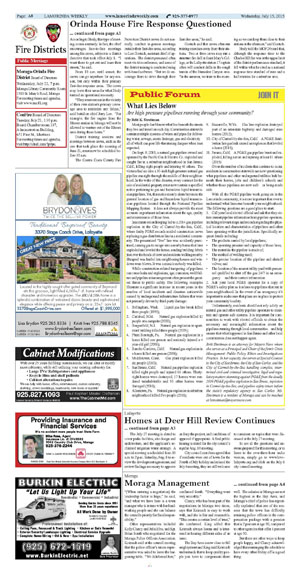|
|
Published July 15th, 2015
|
Public Forum: What Lies Below
|
| Are high-pressure pipelines running through your community? |
| By Britt K. Strottman |
|
|
Most people don't know what lies beneath the streets they live and travel on each day. Communities statewide contain multiple systems of wires and pipes for delivering water, sewage, storm drainage, gas and electricity - all of which can pose life-threatening dangers when least expected.
 On Sept. 9, 2010, a natural gas pipeline owned and operated by the Pacific Gas & Electric Co. exploded and caught fire in a suburban neighborhood in San Bruno, Calif., killing eight people and injuring 66 others. The victims had no idea a 30-inch high-pressure natural gas pipeline ran right through the middle of their neighborhood. In the wake of this disaster, every contract for the sale of residential property must now contain a specified notice pertaining to gas and hazardous liquid transmission pipelines. Yet, that notice merely alerts buyers to the general location of gas and hazardous liquid transmission pipelines located through the National Pipeline Mapping System - it does not always provide the most accurate or pertinent information about the age, quality and maintenance of those lines.
On Sept. 9, 2010, a natural gas pipeline owned and operated by the Pacific Gas & Electric Co. exploded and caught fire in a suburban neighborhood in San Bruno, Calif., killing eight people and injuring 66 others. The victims had no idea a 30-inch high-pressure natural gas pipeline ran right through the middle of their neighborhood. In the wake of this disaster, every contract for the sale of residential property must now contain a specified notice pertaining to gas and hazardous liquid transmission pipelines. Yet, that notice merely alerts buyers to the general location of gas and hazardous liquid transmission pipelines located through the National Pipeline Mapping System - it does not always provide the most accurate or pertinent information about the age, quality and maintenance of those lines.
 Inaccurate recordkeeping led to a 2014 gas pipeline explosion in the City of Carmel-by-the-Sea, Calif., where faulty PG&E records misled construction crews replacing a gas-distribution line in a residential community. The pressurized "live" line was accidently punctured, causing gas to escape into a nearby house that later exploded and leveled the house, sending building debris just over the heads of crew and residents walking nearby. Shrapnel was hurled into neighboring houses and windows were blown. It was a miracle nobody was killed.
Inaccurate recordkeeping led to a 2014 gas pipeline explosion in the City of Carmel-by-the-Sea, Calif., where faulty PG&E records misled construction crews replacing a gas-distribution line in a residential community. The pressurized "live" line was accidently punctured, causing gas to escape into a nearby house that later exploded and leveled the house, sending building debris just over the heads of crew and residents walking nearby. Shrapnel was hurled into neighboring houses and windows were blown. It was a miracle nobody was killed.
 While construction-related tampering of pipelines can cause leaks and explosions, age, corrosion, weld failure and pipeline mismanagement often present the greatest threat to public safety. The following examples illustrate a significant increase in recent years in the number of local incidents and disasters nationwide caused by underground infrastructure failures that were not primarily driven by third-party damage:
While construction-related tampering of pipelines can cause leaks and explosions, age, corrosion, weld failure and pipeline mismanagement often present the greatest threat to public safety. The following examples illustrate a significant increase in recent years in the number of local incidents and disasters nationwide caused by underground infrastructure failures that were not primarily driven by third-party damage:

 1. Bellingham, Wash. - Liquid gas line break killed three people (1999);
1. Bellingham, Wash. - Liquid gas line break killed three people (1999);
 2. Carlsbad, N.M. - Natural gas explosion killed 12 people at a campsite (2000);
2. Carlsbad, N.M. - Natural gas explosion killed 12 people at a campsite (2000);
 3. Bergenfield, N.J. - Natural gas explosion in apartment building killed three people (2005);
3. Bergenfield, N.J. - Natural gas explosion in apartment building killed three people (2005);
 4. Plum Borough, Pa. - Natural gas explosion in a home killed one person and seriously injured a 4 year-old girl (2008);
4. Plum Borough, Pa. - Natural gas explosion in a home killed one person and seriously injured a 4 year-old girl (2008);
 5. Rancho Cordova, Calif. - Natural gas explosion in a home killed one person (2008);
5. Rancho Cordova, Calif. - Natural gas explosion in a home killed one person (2008);
 6. Middletown, Conn. - Gas plant explosion killed six people (2010);
6. Middletown, Conn. - Gas plant explosion killed six people (2010);
 7. San Bruno, Calif. - Natural gas pipeline explosion killed eight people and injured 66 others. Thirty-eight homes were destroyed, 17 homes were rendered uninhabitable and 53 other homes were damaged (2010);
7. San Bruno, Calif. - Natural gas pipeline explosion killed eight people and injured 66 others. Thirty-eight homes were destroyed, 17 homes were rendered uninhabitable and 53 other homes were damaged (2010);
 8. Allentown, Pa. - Natural gas explosion in suburban neighborhood killed five people (2011);
8. Allentown, Pa. - Natural gas explosion in suburban neighborhood killed five people (2011);

 9. Sissonville, W.Va. - Gas line explosion destroyed part of an interstate highway and damaged nine homes (2012);
9. Sissonville, W.Va. - Gas line explosion destroyed part of an interstate highway and damaged nine homes (2012);
 10. City of Carmel-by-the-Sea, Calif. - A PG&E distribution line gas leak caused an explosion that leveled a home (2015);
10. City of Carmel-by-the-Sea, Calif. - A PG&E distribution line gas leak caused an explosion that leveled a home (2015);
 11. Fresno, Calif. - A PG&E gas pipeline burst and exploded, killing a man and injuring at least 11 others (2015)
11. Fresno, Calif. - A PG&E gas pipeline burst and exploded, killing a man and injuring at least 11 others (2015)
 Given the number of incidents that continue to occur, residents in communities statewide are now questioning what pipelines and other underground utilities lurk beneath their homes, jobs and children's schools and whether those pipelines are now safe - or being made safe.
Given the number of incidents that continue to occur, residents in communities statewide are now questioning what pipelines and other underground utilities lurk beneath their homes, jobs and children's schools and whether those pipelines are now safe - or being made safe.
 With all the PG&E pipeline work going on in the Lamorinda community, it is more important than ever to understand what lines run beneath your neighborhood. The following questions are a good place to start:
With all the PG&E pipeline work going on in the Lamorinda community, it is more important than ever to understand what lines run beneath your neighborhood. The following questions are a good place to start:
 1. Call your local elected official and ask that they obtain current pipeline information from pipeline operators, including relevant maps and records regarding the physical location and characteristics of pipelines and other lines operating within the jurisdiction. Specifically request details including:
1. Call your local elected official and ask that they obtain current pipeline information from pipeline operators, including relevant maps and records regarding the physical location and characteristics of pipelines and other lines operating within the jurisdiction. Specifically request details including:
 � The products carried by local pipelines;
� The products carried by local pipelines;
 � The operating pressure and capacity of those lines;
� The operating pressure and capacity of those lines;
 � The materials the pipeline is made of;
� The materials the pipeline is made of;
 � The method of welding used;
� The method of welding used;
 � The precise location of the pipeline and shutoff valves; and
� The precise location of the pipeline and shutoff valves; and
 � The location of the nearest utility yard with personnel qualified to shut off the gas 24/7 in an emergency- and their contact information.
� The location of the nearest utility yard with personnel qualified to shut off the gas 24/7 in an emergency- and their contact information.
 2. Ask your local PG&E operator for a copy of PG&E's safety plan as it relates to pipelines that run in your neighborhood. In the event of an emergency it's important to make sure that plans are in place to protect your community's safety.
2. Ask your local PG&E operator for a copy of PG&E's safety plan as it relates to pipelines that run in your neighborhood. In the event of an emergency it's important to make sure that plans are in place to protect your community's safety.
 Unfortunately, residents should not rely solely on natural gas and other utility pipeline operators to maintain and operate safe systems. It is important for communities to work with elected officials to obtain the necessary and meaningful information about the pipelines running through local communities - and help ensure that what happened in San Bruno and other local communities does not happen again.
Unfortunately, residents should not rely solely on natural gas and other utility pipeline operators to maintain and operate safe systems. It is important for communities to work with elected officials to obtain the necessary and meaningful information about the pipelines running through local communities - and help ensure that what happened in San Bruno and other local communities does not happen again.

 Britt Strottman is an attorney for Meyers Nave where she serves as a Principal and Chair of the firm's Crisis Management: Public Policy, Ethics and Investigations Practice. In her capacity, she serves as Special Counsel to the City of San Bruno, the City of San Carlos, and the City of Carmel-by-the-Sea handling complex, intertwined civil and criminal investigative, legal and regulatory matters stemming against PG&E from the deadly 2010 PG&E pipeline explosion in San Bruno, explosion in Carmel-by-the-Sea, and pipeline safety issues before the state's regulatory agency in San Carlos. Ms. Strottman is a resident of Moraga and can be reached at bstrottman@meyersnave.com.
Britt Strottman is an attorney for Meyers Nave where she serves as a Principal and Chair of the firm's Crisis Management: Public Policy, Ethics and Investigations Practice. In her capacity, she serves as Special Counsel to the City of San Bruno, the City of San Carlos, and the City of Carmel-by-the-Sea handling complex, intertwined civil and criminal investigative, legal and regulatory matters stemming against PG&E from the deadly 2010 PG&E pipeline explosion in San Bruno, explosion in Carmel-by-the-Sea, and pipeline safety issues before the state's regulatory agency in San Carlos. Ms. Strottman is a resident of Moraga and can be reached at bstrottman@meyersnave.com.

|
|
|
|
|
|
|
|
|
| |
|
|
|
|



